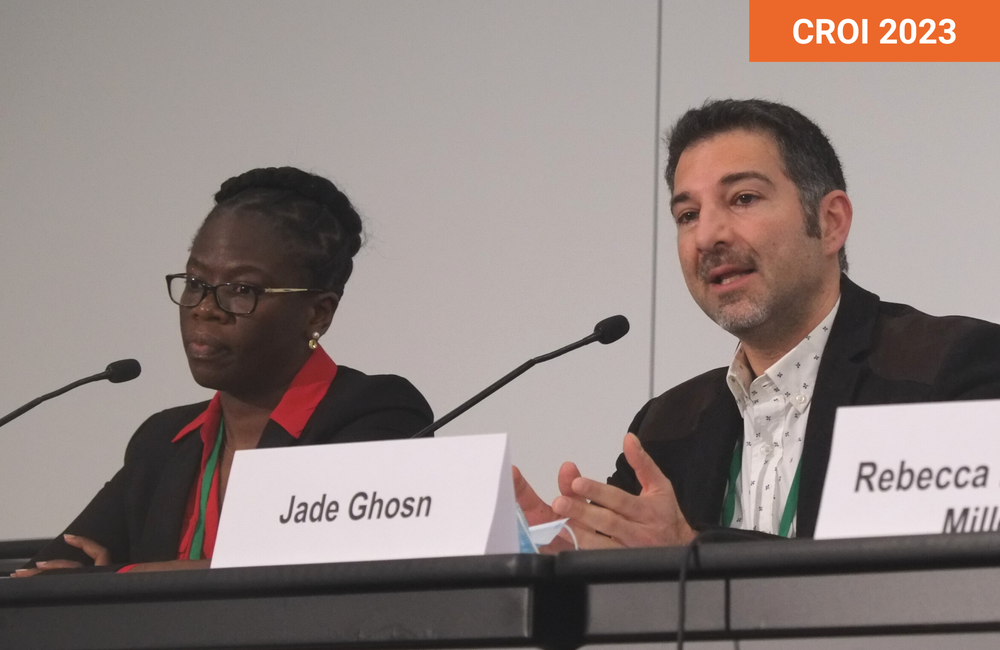
When the mpox (monkeypox) virus began rapidly spreading to non-endemic countries in 2022, smallpox vaccines were widely recommended not only as post-exposure prophylaxis to minimise symptoms of the illness, but also to prevent infection. At the time, however, few data existed in humans to predict how effective a vaccine designed for smallpox would fare against its sister orthopoxvirus, mpox.
Yesterday, at the 30th Conference on Retroviruses and Opportunistic Infections (CROI 2023) in Seattle, researchers from France and the United States presented separate findings that add to the data on how effective smallpox vaccines are at preventing mpox infections.
On 10 May 2022, the first mpox case in France was reported while Dr Jade Ghosn of the University of Paris Cité and colleagues were in the midst of the DOXYVAC clinical trial, designed to evaluate how well doxyPEP and a meningococcal B vaccine prevent sexually transmitted infections (STIs). Their cohort was gay and bisexual men on PrEP (regular medication to prevent HIV) with a recent history of an STI; a population more likely to contract mpox.
On 11 July, French health authorities ramped up initial vaccination efforts, launching a campaign to administer a dose of the third-generation smallpox vaccine to gay and bisexual men who have multiple sexual partners. This vaccine was deployed in most countries in the 2022 outbreak, known as MVA-BN and sold as Imvanex in Europe and Jynneos in the US.
“Because of the increasing numbers of cases of mpox within study participants, we urged clinical centres [taking part] in the trial to reach out to participants and schedule the first shot of vaccine as soon as possible,” Ghosn said at the conference.
A high percentage (87%) of the 472-person cohort that had enrolled in the DOXYVAC trial received a single dose of the vaccine by 31 August, enabling the researchers to assess changes in mpox incidence in the population before and after the French government’s vaccine campaign.
Most participants were in their 30s or 40s and were university-educated. Half had more than ten partners in the past three months, just under a third went to sex parties and a fifth had used drugs the last time they had sex. A fifth had received a first- or second-generation smallpox vaccination in childhood.
Mpox cases occurred in 77 of the participants, 61 occurring before the 11 July vaccination campaign, and 16 occurring after, corresponding to incidences per person-months of 67.4 and 24.4, respectively.
In the first analysis, incidence was lower for men with childhood vaccination and higher for men with more sexual partners, but after statistical adjustment, the only factor linked to fewer infections was receiving the MVA-BN vaccine. Comparing incidence rate ratios with men who didn’t get vaccinated showed that the third-generation vaccine was 99% effective at preventing mpox infection (p = <.001).
Ghosn pointed out that the effectiveness rates are above what other studies estimate because members of their cohort were proactively urged to get the vaccine and did not have to wait for doses to become available – in contrast to the situation for other people.
Dr Boghuma Titanji of Emory University investigated how effective first-generation (Dryvax) or second-generation (ACAM2000) vaccines were at preventing mpox. She and her colleagues conducted a retrospective analysis using military health data from either the US Department of Defense or the Veterans Health Administration.
From these data, the researchers identified 1007 people who tested for mpox infection over a four-month period during the outbreak. Although routine vaccination of the general public ended in 1972, the US military vaccinated their personnel against smallpox between 2002 and 2017, and the cohort contained 208 people (21%) with a history of receiving either Dryvax or ACAM2000. The group was mostly male (92%), ranged in age between 18 and 34 years, and contained a significant portion of people living with HIV (29%).
Almost 300 people (30%) tested positive for mpox. Comparing incidence rates among those who hadn’t received a vaccine and those who had, showed Dryvax was 66% effective at preventing mpox infection while ACAM2000 was 72% effective. Furthermore, previous vaccinations were both effective at preventing 59% of hospitalisations after infection.
Cases of mpox were almost 12 times more likely in males and appeared more frequently in younger people. In addition, people with HIV were more than twice as likely to test positive for mpox; however, the reason is unclear. Due to safety concerns, first- and second-generation smallpox vaccines are not recommended for people with HIV. Titanji said they didn't know if people in their cohort had previously acquired HIV and were ineligible to receive vaccines between 2002 and 2017, or whether they received a vaccine and acquired HIV during their military service. If the latter, it’s possible the higher incidence reflects faster waning of vaccine effectiveness in people with compromised immune systems.
Titanji concluded that while these older vaccines protect against mpox, the protection they offer is “not absolute”. As a result, more research should investigate the role boosters may need to play in previously vaccinated people.
Ghosn J et al. Impact of vaccination on mpox incidence in MSM on PrEP in the ANRS 174 DOXYVAC trial. Conference on Retroviruses and Opportunistic Infections, Seattle, abstract 208, 2023.
View the abstract on the conference website.
Titanji BK et al. Effectiveness of smallpox vaccination to prevent mpox in military personnel. Conference on Retroviruses and Opportunistic Infections, Seattle, abstract 207, 2023.
View the abstract on the conference website.

